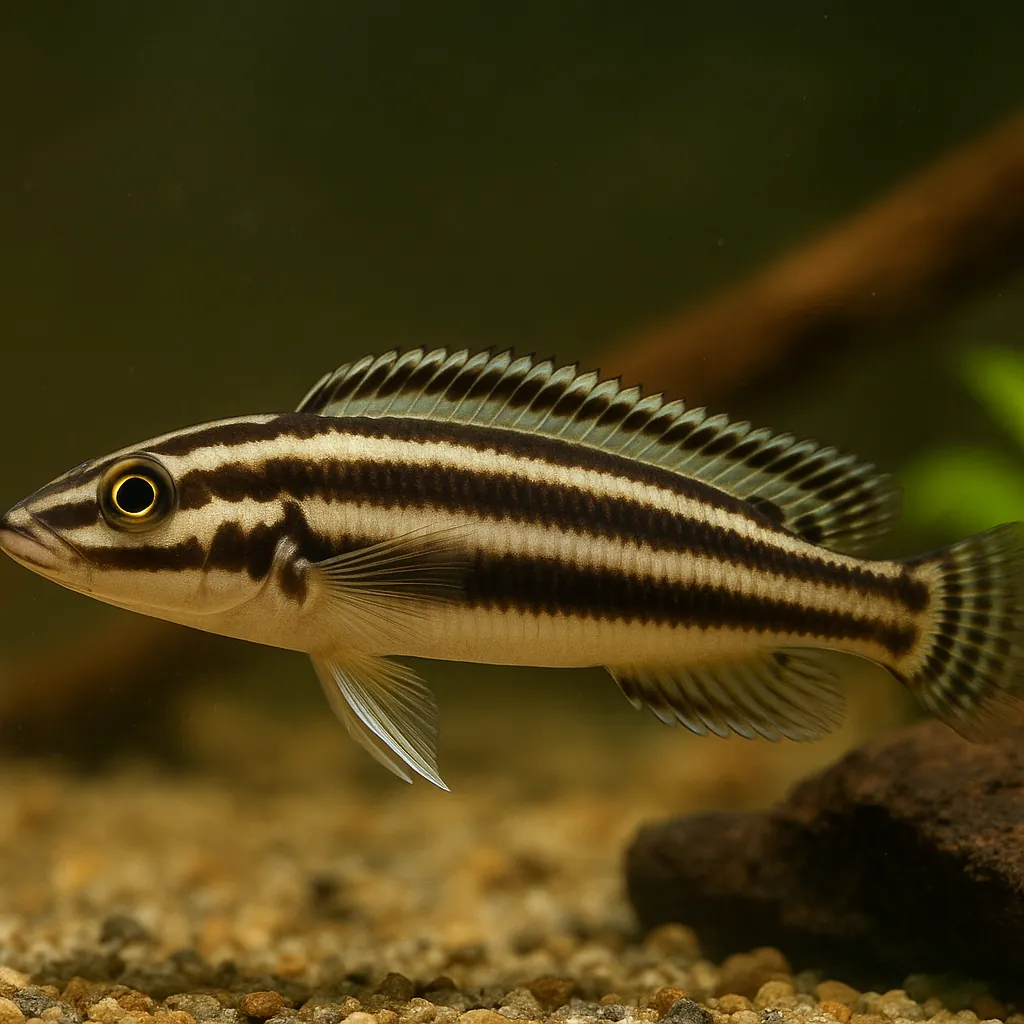
Striped julie
Introduction
The Striped Julie, scientifically known as Julidochromis regani, is a captivating freshwater fish native to Lake Tanganyika in Africa. Renowned for its elongated body adorned with striking horizontal stripes, this species has become a favorite among aquarists seeking to add both beauty and intrigue to their tanks. While the Striped Julie offers a rewarding experience, it requires specific care conditions, making it more suitable for aquarists with some experience.
Care and Environment
Providing the right environment is crucial for the health and well-being of the Striped Julie. Here's a comprehensive guide to their care:
What is the minimum tank size for a Striped Julie?
A minimum tank size of 208 liters (55 gallons) is recommended to accommodate a pair of Striped Julies. This space allows them to establish territories and exhibit natural behaviors.
What are the ideal water parameters for Striped Julies?
Maintaining stable water conditions is essential. Aim for a temperature range of 22-25°C (71.6-77°F), a pH between 8.5 and 9.2, and water hardness between 8-14 dGH. Consistent monitoring and maintenance of these parameters will help ensure a healthy environment.
How should the tank be set up for Striped Julies?
Replicating their natural rocky habitat is key. Incorporate plenty of rocks and caves to provide hiding spots and territories. A sandy or fine gravel substrate is ideal, and while plants can be included, ensure they are hardy species that can withstand the cichlids' activities.
What type of filtration and lighting do Striped Julies require?
Efficient filtration is necessary to maintain water quality, as Striped Julies are sensitive to poor conditions. Moderate lighting is sufficient, but ensure there are shaded areas within the tank to mimic their natural environment.
What should I feed my Striped Julies?
Striped Julies are omnivorous. Offer a varied diet that includes high-quality cichlid pellets or flakes, supplemented with live or frozen foods such as bloodworms, brine shrimp, and daphnia. Feeding once or twice a day is typically adequate.
Are there any specific challenges in keeping Striped Julies?
Be aware of their territorial nature, especially during breeding. They can become aggressive towards their own kind and other fish during spawning periods. Providing ample space and hiding spots can help mitigate aggression.
Origin and Habitat
The Striped Julie hails from the rocky shorelines of Lake Tanganyika, one of Africa's Great Lakes. This vast freshwater lake is known for its clear, alkaline waters and abundant rocky formations. Striped Julies inhabit the crevices and caves among these rocks, which offer protection from predators and serve as breeding sites. The lake's stable temperature and pH levels contribute to the specific care requirements of this species in captivity.
Temperament and Compatibility
Understanding the behavior of Striped Julies is essential for creating a harmonious aquarium:
Are Striped Julies peaceful or aggressive?
Striped Julies are known for their territorial behavior. They can be aggressive towards their own kind and other fish, especially during breeding periods.
Do Striped Julies shoal?
No, Striped Julies do not shoal. They are more solitary and prefer to establish their own territories within the tank.
What tank mates are suitable for Striped Julies?
It's best to keep them in African cichlid setups only. They should not be kept with smaller fish, particularly ones that can fit in their mouth. Suitable tank mates include other similarly sized Tanganyikan cichlids that can hold their own.
Interesting Facts
Here are some intriguing aspects of the Striped Julie:
How do Striped Julies behave in their natural habitat?
In the wild, Striped Julies are adept at navigating rocky terrains, often swimming upside down along cave ceilings and crevices.
What is unique about their breeding behavior?
They are cave spawners, with females laying eggs on the walls or ceilings of caves. Both parents are involved in guarding the eggs and fry, showcasing strong parental instincts.
How long do Striped Julies typically live?
With proper care, Striped Julies can live between 5 to 8 years in captivity, providing aquarists with years of enjoyment.
Sources
All information in this article has been gathered from the following reputable sources:
Overview
Recommended Tank Size 54.9 Gallons (suitable for a pair) |
Minimum Group Size 2 |
Minimum Tank Volume 54.9 Gallons |
Maximum Adult Length 5.1 inches |
Average Adult Length 3.9 inches |
Shoaling (6+ required) No |
Preferred Water Type Freshwater, hard, alkaline |
Temperature Range (°C) 22-25 |
pH Range 8.5-9.2 |
Water Hardness (dGH) 8-14 |
Typical Lifespan (years) 5 years |